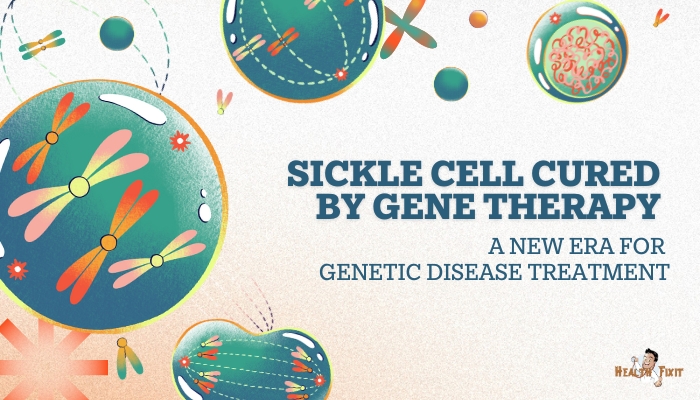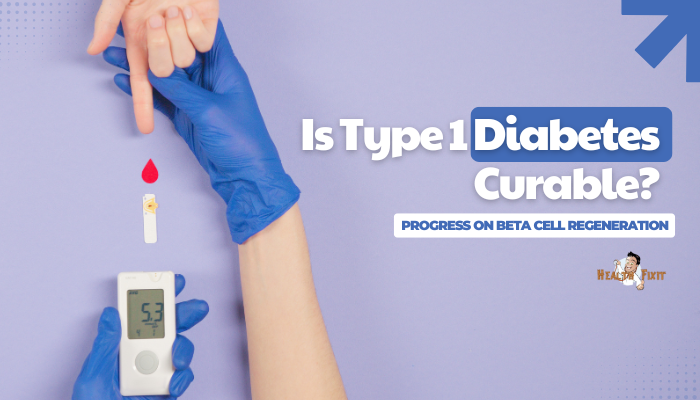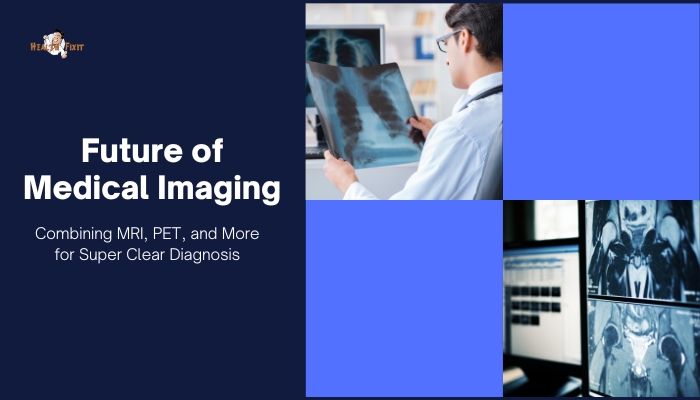Introduction
Sickle cell disease (SCD) is an inherited blood disorder. It changes healthy red blood cells into a crescent, or “sickle,” shape. These sickled cells do not move through small vessels easily.
As a result, people with SCD often suffer pain, organ issues, and other health problems. For decades, treatment relied on supportive care, transfusions, and certain drugs. While these measures reduce symptoms, they are not cures.
Bone marrow transplantation can cure some patients, but many do not have suitable donors or cannot tolerate the procedure.
In the last few years, researchers have made major advances in gene therapy. Now, there are real examples of patients whose SCD symptoms resolved after gene-editing procedures.
This marks a profound turning point. Gene therapy addresses the actual cause of SCD: a defect in the beta-globin gene.
This approach rewires cells at the genetic level to create functional hemoglobin. The hope is that this breakthrough will end the cycle of pain and transform long-term outcomes.
This article explains how sickle cell disease arises, details the evolution of gene therapy, and outlines the remarkable possibilities that gene-editing technology may hold for other genetic conditions.
It also describes potential challenges, including cost, access, and regulatory hurdles. By combining clinical successes with ongoing research, we can see how gene therapy stands at the edge of a new era in treating and potentially curing genetic diseases.
Sickle Cell Disease at a Glance
Sickle cell disease arises from a single genetic change in the beta-globin chain of hemoglobin, the protein that carries oxygen in red blood cells. Instead of flexible disc-shaped cells, a subset of red blood cells become rigid and shaped like a sickle. These misshapen cells stick to vessel walls, reducing blood flow and oxygen delivery to tissues.
Causes and Genetic Basis
- Beta-Globin Gene Mutation: The mutation is a single base substitution in the HBB gene on chromosome 11. This alters normal hemoglobin (HbA) into sickle hemoglobin (HbS).
- Autosomal Recessive: A child needs two copies of the sickle mutation to manifest SCD. Individuals with one mutated gene and one normal gene (carriers) have sickle cell trait. They may have mild or no symptoms.
When red blood cells have excess sickle hemoglobin, they can polymerize under low-oxygen conditions. This polymerization changes the cell’s shape, triggering inflammation, obstructing microcirculation, and causing pain.
Common Symptoms
- Pain Crises: These are also called vaso-occlusive episodes. Sickled cells block small vessels, causing tissue damage and severe pain.
- Anemia: The lifespan of sickled cells is shorter. This leads to chronic hemolysis and lower hemoglobin levels.
- Organ Damage: Repeated blockages impair kidney, spleen, and liver function. Over years, people with SCD can suffer strokes, heart issues, and infections.
Conventional Treatments
- Hydroxyurea: This medication boosts fetal hemoglobin (HbF) production, which reduces sickling.
- Blood Transfusions: They provide normal red blood cells to lower the proportion of sickled cells.
- Pain Management: Opioids and other drugs help with crises. IV fluids and oxygen can relieve symptoms.
- Bone Marrow Transplant: Replacing the patient’s marrow with donor cells can cure SCD in some cases. However, it requires a matched donor and involves risks like graft-versus-host disease.
Despite major improvements in supportive care, these treatments often continue for a lifetime. Pain crises, stroke risk, and infection remain serious threats. By contrast, gene therapy seeks to correct the underlying cause, offering hope of a permanent solution.
What Is Gene Therapy?
Gene therapy corrects or compensates for genetic defects by altering the patient’s own cells. For SCD, the primary goal is to fix or bypass the mutation in the beta-globin gene. Scientists can do this in different ways, such as introducing a functional gene copy or adjusting regulators of hemoglobin production.
Two Main Techniques
- Ex Vivo Gene Therapy:
- Patient’s stem cells are harvested from bone marrow or peripheral blood.
- These cells are modified in a lab to carry corrected genetic information.
- The patient receives conditioning treatment (usually chemotherapy) to clear out existing bone marrow.
- Modified cells are infused back into the patient, where they rebuild healthy red blood cells.
- Patient’s stem cells are harvested from bone marrow or peripheral blood.
- In Vivo Gene Therapy:
- Gene-editing tools are delivered directly into the patient’s body.
- Cells in the bone marrow undergo correction without removing them first.
- Gene-editing tools are delivered directly into the patient’s body.
For SCD, most gene therapy research has focused on ex vivo approaches. This method allows precise editing of patient cells before reintroduction.
Tools for Gene Editing
- Viral Vectors: Researchers use vectors derived from lentiviruses or other viruses to deliver a healthy beta-globin gene.
- CRISPR-Cas9: This is a powerful gene-editing technology. CRISPR guides an enzyme (Cas9) to the mutated gene, where it can cut DNA. Scientists then fix or alter the gene.
- Base Editors or Prime Editors: These refined technologies edit single bases or small DNA segments. They can correct the mutation more accurately than CRISPR alone.
Immune and Safety Considerations
When gene therapy uses viruses, immune reactions can occur. Patients also need conditioning therapy to allow gene-edited cells to engraft.
This can be physically taxing. Even with CRISPR or advanced editors, scientists monitor potential off-target changes to ensure no harmful mutations arise elsewhere in the genome.
Landmark Gene Therapy Trials for Sickle Cell
In the last few years, multiple clinical trials have advanced from preclinical phases to human studies. These trials investigate lentiviral vectors or CRISPR-based editing in patients who have severe SCD manifestations.
Lentiviral Gene Addition Approaches
One of the earliest approaches used a modified virus to carry a functional beta-globin gene into the patient’s stem cells.
The newly introduced gene allows red blood cells to produce healthy hemoglobin. Early trial data showed many patients had fewer pain crises and needed fewer transfusions. Some achieved near-normal hemoglobin function.
CRISPR-Based Trials
Another set of trials used CRISPR-Cas9 to edit a regulatory region of the BCL11A gene. This gene influences the switch from fetal hemoglobin (HbF) to adult hemoglobin (HbA).
By turning off the repressor, the patient’s cells produce higher levels of fetal hemoglobin. This approach bypasses the sickle mutation by increasing HbF, which does not sickle.
Patients who participated in these trials reported major improvements. Pain crises declined, and their hemoglobin levels improved.
Recent updates confirm that CRISPR-treated cells can persist in the body for over a year, indicating stable engraftment.
Real-World Examples
Several news stories have featured patients who once endured frequent hospital admissions and intense pain. After receiving gene therapy, many have been nearly symptom-free.
Some even returned to school or work with minimal disruption. These cases offer tangible proof that gene therapy can transform SCD care.
Mechanisms of Action: How Gene Therapy Cures Sickle Cell
Gene therapy trials employ multiple strategies to address the mutation in the beta-globin gene:
- Gene Replacement: Insert a functional beta-globin gene copy into stem cells. The cell can then produce normal or near-normal hemoglobin.
- Fetal Hemoglobin Reactivation: Instead of fixing the defective gene, therapy can raise HbF production by silencing the BCL11A repressor. Because HbF does not polymerize under low oxygen, it reduces sickling.
- Precise Correction: Some researchers aim to repair the actual single-base defect in the HBB gene. This approach can restore true adult hemoglobin. However, it is still under investigation to ensure safety and high efficiency.
All these methods seek to change the balance of hemoglobin in red blood cells. If enough functional hemoglobin outcompetes the sickled form, patients experience fewer crises and complications.
Potential Benefits Beyond Sickle Cell
SCD gene therapy paves the way for treating other hemoglobinopathies, such as beta-thalassemia. This disorder also involves defective beta-globin chains.
Early results indicate that gene-editing protocols developed for SCD can help patients with thalassemia reduce or stop transfusions.
Lessons for Other Genetic Diseases
Researchers note that strategies built for SCD might apply to other inherited blood disorders or even diseases involving immune cells.
The ex vivo process of extracting stem cells, editing them, and reinfusing them could address many monogenic conditions. Innovations in CRISPR design, viral delivery, or advanced editing tools also have broad potential. For instance, gene therapies for muscular dystrophies or certain metabolic disorders are in progress.
Limitations
Blood-based disorders are often easier to treat with ex vivo editing. Cells can be collected, modified, and transplanted back. Many other genetic diseases involve organs like the brain, heart, or liver, which can be more difficult to access. Also, not every disease has a single base change or a single gene to fix. Some complex disorders involve multiple genes or environmental triggers. Still, the success in SCD encourages scientists to refine gene therapy for a broader range of conditions.
Risks, Costs, and Accessibility
Gene therapy is complex. It is not as simple as taking a pill. It requires specialized facilities, skilled staff, and an intensive process for each patient.
Short-Term Risks
- Conditioning Therapy: Patients often need high-dose chemotherapy to clear bone marrow space. Chemotherapy carries side effects like hair loss, infection risk, and possible fertility impacts.
- Immune Reactions: Viral vectors can trigger immune responses. Clinicians must manage or prevent these.
- Off-Target Edits: CRISPR might cut DNA outside the intended site, but advanced techniques reduce this risk.
Long-Term Monitoring
Experts watch patients for any sign that gene-edited cells cause abnormal growth or malignancies. So far, this risk appears low in SCD trials, but more data over time will be helpful. Patients also undergo blood work to confirm that gene-edited cells remain and continue expressing healthy hemoglobin.
Cost and Access
Gene therapy can cost hundreds of thousands or even millions of dollars per treatment. Manufacturing each batch of cells is labor-intensive. Insurance coverage is uncertain in many places. Low-resource settings often lack the required infrastructure. This is significant because sickle cell disease rates are high in parts of Africa, the Middle East, and India.
There is growing pressure on pharmaceutical companies, healthcare systems, and policymakers to ensure equitable access. Advocates argue that gene therapy should not be a luxury for people in wealthy nations only. Collaborative efforts among governments, nonprofits, and industry may bring more affordable treatment models.
A Closer Look at the Procedure
Below is a simplified table showing key steps in ex vivo gene therapy for SCD:
| Step | Process | Goal |
| 1. Patient Evaluation | Medical tests, stable condition check | Confirm eligibility, reduce risks |
| 2. Stem Cell Collection | Harvest blood or bone marrow cells | Gather hematopoietic stem cells |
| 3. Conditioning | High-dose chemotherapy | Clear marrow for edited cell engraftment |
| 4. Gene Editing | Lab modifies cells with viral vectors or CRISPR | Insert or correct beta-globin, or upregulate HbF |
| 5. Cell Infusion | Edited cells transfused back into patient | Rebuild healthy marrow that makes functional RBCs |
| 6. Recovery & Monitoring | Watch for side effects, measure hemoglobin, reduce pain crises | Ensure gene-edited cells persist long-term |
The entire process can take weeks to months. Patients typically stay near specialized hospitals. After infusion, they need consistent follow-ups to confirm stable engraftment and check for complications.
Regulatory Outlook and Milestones
Many gene therapy products are in advanced clinical trials, aiming for formal approval by agencies like the FDA and EMA. In some cases, these regulators have granted “Breakthrough Therapy” or “Priority Review” designations to speed up evaluation, given the therapy’s potential to address unmet medical needs.
Partial Approvals and Compassionate Use
For certain patients with severe, life-threatening SCD, compassionate use programs may allow access to gene therapy before full approval. This can save lives but also requires oversight to monitor safety and efficacy.
Future Pathways
Experts anticipate that once a gene therapy is fully approved, coverage policies, manufacturing capacity, and distribution logistics will shape real-world impact. A single gene therapy for SCD could drastically reduce hospitalizations. Countries may weigh up-front costs against long-term savings from fewer medical visits and less disability.
Ethical and Social Dimensions
Gene therapy raises ethical questions about patient selection, potential genetic enhancement, and equity. Some people fear that editing DNA may open the door to designer treatments for non-medical traits. However, current SCD therapies focus on a recognized disease-causing mutation.
Patient Consent and Informed Choice
Patients must understand the procedure’s risks, including infertility from chemotherapy. They also need to weigh the possibility of a cure against uncertainty about side effects. Clear, transparent counseling ensures that families or guardians make informed decisions.
Addressing Global Burden
SCD disproportionately affects people of African descent and certain communities in India, the Middle East, and the Caribbean. Many of these regions have limited healthcare resources. Even if gene therapy becomes widely available in high-income countries, bridging the gap for low-income settings remains challenging. Partnerships among governments, charities, and pharmaceutical companies can expand testing, safe gene editing, and healthcare training.
The Role of Advocacy
Patient advocacy groups have pushed for more public awareness about sickle cell disease. They help shape policies, influence research funding, and amplify patient voices. This involvement is crucial to maintain focus on equitable solutions. Gene therapy for SCD can succeed only if large segments of the affected population can access it.
Balancing Hopes and Realities
Gene therapy trials often inspire excitement. While there is good reason for hope, patients should be aware that not everyone will qualify. Some individuals have medical conditions that make the conditioning process too risky. Others cannot leave work or family duties for extended hospital stays. Also, the therapy might not be 100% effective for every patient.
Durability of Results
Data so far show that corrected cells can persist for several years, and patients experience less sickling. However, we lack decades-long follow-up. There may be a need for long-term registries to monitor late effects, especially if changes in gene expression or cell behavior occur.
Evolving Technology
CRISPR and other editing tools continue to refine. Future versions might minimize off-target cuts even further. Researchers also explore gentler conditioning regimens, possibly using antibodies that target stem cells instead of traditional chemotherapy. This might reduce toxicity and broaden eligibility.
Combining Approaches
Some SCD patients have complex organ complications or co-infections that gene therapy cannot fix alone. Care teams still rely on standard treatments—pain management, transfusions, hydroxyurea—to keep patients stable before or after therapy. In time, new drug discoveries or supportive therapies may complement gene correction methods.
Patient Perspective: A Glimpse of the Future
Imagine a 10-year-old with repeated hospital visits due to pain crises and acute chest syndrome. Under conventional treatment, they might face frequent absences from school. Family life would revolve around clinic visits and medication schedules. With gene therapy, that child’s red blood cell production could normalize, or fetal hemoglobin could rise enough to prevent sickling. Hospital stays might plummet, letting the child focus on everyday life.
As more patients undergo successful gene therapy, the quality-of-life improvements become obvious. Some might even test negative for all SCD markers, effectively curing the disease at the biological level. This lifts a huge psychological and financial burden from families. Beyond the personal sphere, entire healthcare systems would see fewer acute admissions for sickle cell crises, freeing resources for other needs.
Next Steps for Wider Impact
Gene therapy stands at the frontier of modern medicine. To leverage this for sickle cell disease worldwide, several steps remain:
- Regulatory Approvals: Companies must complete trial data submissions and pass safety reviews for official clearance.
- Cost Containment: High price tags must be tackled through public-private funding, special insurance models, and philanthropic aid.
- Infrastructure Growth: Specialist centers with cell-processing labs and skilled staff are needed to deliver gene therapy.
- Community Education: Patients and families need clear, reliable information about gene therapy’s process, benefits, and risks.
- Global Partnerships: Partnerships across borders can share technology, train personnel, and secure supply chains.
If these facets align, we could see a revolution in how societies treat inherited blood disorders.
Looking Ahead: Curing Genetic Diseases Beyond SCD
Sickle cell disease is a prime example of a single-gene disorder with devastating consequences. Its prominence in certain ethnic groups also made it a high priority for gene therapy research. Now that gene editing for SCD is proving successful, scientists envision tackling an array of genetic conditions:
- Beta-Thalassemia: Another hemoglobin disorder. Patients have fewer healthy red blood cells and often need lifelong transfusions.
- Cystic Fibrosis: A gene defect causes thick mucus in lungs and other organs, leading to infections and organ damage.
- Spinal Muscular Atrophy: Missing or altered SMN1 gene leads to muscle weakness.
- Duchenne Muscular Dystrophy: Mutations in the dystrophin gene cause progressive muscle damage.
The blueprint for these diseases might mirror that of SCD. If scientists can safely edit or restore the function of a single gene, they can potentially shift a patient’s prognosis from terminal to manageable—or even curable. Each condition has unique challenges, such as the need to target cells outside the bone marrow, but the core principle remains: fix the genetic error at its source.
Conclusion
Gene therapy is beginning a new era of medical treatment for sickle cell disease. By replacing or correcting defective genes in a patient’s own blood-forming cells, researchers can address the root cause. Early successes in clinical trials are promising, with many participants experiencing far fewer pain crises and improved quality of life. Regulatory agencies are moving closer to full approvals, though cost and availability remain questions.
SCD has historically meant a lifetime of painful crises, hospital stays, and organ damage. Now, gene therapy offers a real possibility of a “once-and-done” procedure that could normalize blood function. This innovation not only has immediate value for individuals with SCD, but it also sets a roadmap for other inherited conditions. Society faces challenges around funding, infrastructure, and equitable access, yet these obstacles can be overcome if stakeholders join forces.
The next decade could be transformative. If gene therapy becomes standard practice for sickle cell disease, children born with this genetic condition might avoid many of the struggles faced by older generations. In time, the same approach may tackle other debilitating genetic diseases, improving life for millions. The journey from pioneering lab studies to everyday clinical availability is long, but the progress so far signals that sickle cell might finally be on the verge of a definitive cure.
References
- Inusa BPD, Levon B, Lia N, et al. Sickle cell disease: Management options and challenges in developing countries. Mediterr J Hematol Infect Dis. 2019;11(1):e2019012.
- Kato GJ, Piel FB, Reid CD, et al. Sickle cell disease. Nat Rev Dis Primers. 2018;4(1):18010.
- Williams TN, Weatherall DJ. World distribution, population genetics, and health burden of the hemoglobinopathies. Cold Spring Harb Perspect Med. 2012;2(9):a011692.
- Hsieh MM, Fitzhugh CD, Weitzel RP, et al. Nonmyeloablative hematopoietic stem cell transplantation for sickle cell disease: A transformative therapy. Blood. 2014;123(21):3349–3354.
- Ribeil JA, Hacein-Bey-Abina S, Payen E, et al. Gene therapy in a patient with sickle cell disease. N Engl J Med. 2017;376(9):848–855.
- DeWitt MA, Magis W, Bray NL, et al. Selection-free genome editing of the sickle mutation in human adult hematopoietic stem/progenitor cells. Sci Transl Med. 2016;8(360):360ra134.
- Frangoul H, Altshuler D, Cappellini MD, et al. CRISPR-Cas9 gene editing for sickle cell disease and β-thalassemia. N Engl J Med. 2021;384(3):252–260.
- Hoban MD, Orkin SH, Bauer DE. Genetic treatment of a molecular disorder: gene therapy approaches to sickle cell disease. Blood. 2016;127(7):839–848.
- Esrick EB, Lehmann LE, Biffi A, et al. Post-transcriptional genetic silencing of BCL11A to treat sickle cell disease. N Engl J Med. 2021;384(3):205–215.
- Thom CS, Dickson CF, Gell DA, Weiss MJ. Hemoglobin variants: biochemical properties and clinical correlates. Cold Spring Harb Perspect Med. 2013;3(3):a011858.
- Cavazzana M, Ribeil JA, Payen E, et al. Outcomes of gene therapy for beta-hemoglobinopathies. Hum Gene Ther. 2021;32(17-18):894–904.
- Walters MC, Patience M, Lezon-Geyda K, et al. Gene-corrected autologous hematopoietic stem cell transplantation for sickle cell disease. Blood Adv. 2022;6(7):1981–1993.





